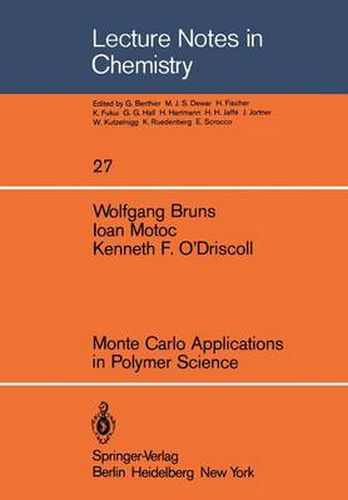Readings Newsletter
Become a Readings Member to make your shopping experience even easier.
Sign in or sign up for free!
You’re not far away from qualifying for FREE standard shipping within Australia
You’ve qualified for FREE standard shipping within Australia
The cart is loading…






This title is printed to order. This book may have been self-published. If so, we cannot guarantee the quality of the content. In the main most books will have gone through the editing process however some may not. We therefore suggest that you be aware of this before ordering this book. If in doubt check either the author or publisher’s details as we are unable to accept any returns unless they are faulty. Please contact us if you have any questions.
The aim of this chapter is to discuss in detail the Monte Carlo algorithms developed to compute the sequence distributions in polymers. Because stereoregular polymers constitute a unique form of copolymer, the stereosequence distributions in vinyl homopolymers and the sequence distributions in copolymers can be computed using the same algorithms. Also included is a brief review of probabilistic models (i. e. , Bernoulli trials and Markov chains) frequently used to compute the sequence distribtuion. The determination of sequence distributions is important for the under- standing of polymer physical properties, to compute the monomer reactivity para- meters and to discriminate among polymerization mechanisms. 2. 2. Short review of analytical models, Monte Carlo algorithms and computer programs. l A Bernoullian model was developed by Price. Within this model the probability of a given state of the system is independent of the previous state and does not condition the next state. The Bernoullian behaviour has been shown 24 to describe cls-trans distributions among 1, 4 additions in polybutadienes - , 5 the comonomer distribution in ethylene-vinyl acetate copolymer , and configura- 6 tional distributions in polystyrene , poly (vinyl chloride)7, poly (vinyl alcohol)7 Consider the binary copolymerization:;1,J=1,2 (1) where - MI* , I = 1,2, is an ionic or radical polymeric chain end, and M, J = 1,2, J is a monomer. Because the final state (i. e.
$9.00 standard shipping within Australia
FREE standard shipping within Australia for orders over $100.00
Express & International shipping calculated at checkout
Stock availability can be subject to change without notice. We recommend calling the shop or contacting our online team to check availability of low stock items. Please see our Shopping Online page for more details.
This title is printed to order. This book may have been self-published. If so, we cannot guarantee the quality of the content. In the main most books will have gone through the editing process however some may not. We therefore suggest that you be aware of this before ordering this book. If in doubt check either the author or publisher’s details as we are unable to accept any returns unless they are faulty. Please contact us if you have any questions.
The aim of this chapter is to discuss in detail the Monte Carlo algorithms developed to compute the sequence distributions in polymers. Because stereoregular polymers constitute a unique form of copolymer, the stereosequence distributions in vinyl homopolymers and the sequence distributions in copolymers can be computed using the same algorithms. Also included is a brief review of probabilistic models (i. e. , Bernoulli trials and Markov chains) frequently used to compute the sequence distribtuion. The determination of sequence distributions is important for the under- standing of polymer physical properties, to compute the monomer reactivity para- meters and to discriminate among polymerization mechanisms. 2. 2. Short review of analytical models, Monte Carlo algorithms and computer programs. l A Bernoullian model was developed by Price. Within this model the probability of a given state of the system is independent of the previous state and does not condition the next state. The Bernoullian behaviour has been shown 24 to describe cls-trans distributions among 1, 4 additions in polybutadienes - , 5 the comonomer distribution in ethylene-vinyl acetate copolymer , and configura- 6 tional distributions in polystyrene , poly (vinyl chloride)7, poly (vinyl alcohol)7 Consider the binary copolymerization:;1,J=1,2 (1) where - MI* , I = 1,2, is an ionic or radical polymeric chain end, and M, J = 1,2, J is a monomer. Because the final state (i. e.